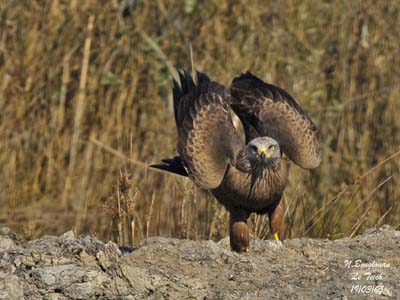
Black Kite
(Milvus migrans)
Accipitriforme Order – Accipitridae Family
As soon as early March, I scan for a long time the sky above the forest, hoping to see his beautiful silhouette soaring at tree tops or higher in the blue sky.
And finally one fine morning I raise my head, and I see several kites rising towards the sun, benefitting from the thermal currents which carry them. They fly while circling in more or less wide movements, and their high-pitched calls accompany their ascension “kuil-ierr-kuil-ierr”. The wind carries these characteristic calls far off. It is spring. Pairs are going to start immediately their courtship displays. It is hurry… they have to go away again as soon as August!
It just alighted. Its dusky plumage explains well its name. But the sun emphasizes the reddish edges of some feathers, forming on its shoulders some almost golden glistening reflections. The very pale grey head and neck are streaked black, and contrast with the darker back. Throat and breast show identical streaks, with more reddish shades.

The piercing eyes sparkle with a warm brown-yellow colour. The powerful bright yellow bill is black-tipped and hooked. The bright yellow legs armed with powerful talons show reddish feathered thighs. The dark tail, barred with darker lines, presents a typical V, allowing the identification in flight, when it soars in the sky.
Its light and flexible flight emphasizes the fairly dark under wings, but with whitish marks at tips. The tail allows the stabilization of this beautiful raptor in the air, and various kinds of postures. It soars with elegance, strongly rises and goes down abruptly, or follows invisible circles which lead it to one hundred metres of altitude, sometimes more.
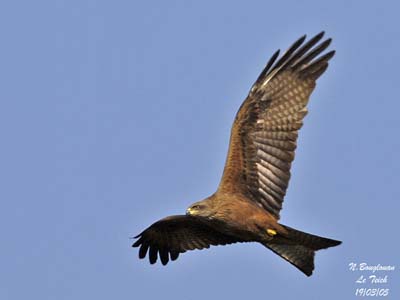
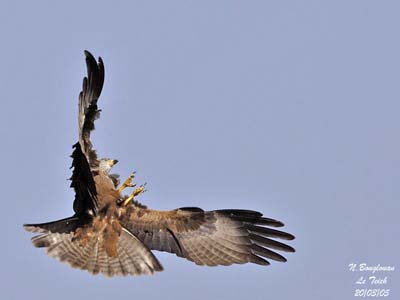
Its flight’s virtuosity explodes during the displays. Aerobatics at high elevation follow one another, seeing the pairs rising, going down, chasing each other, crossing, touching in flight, and gliding side by side, sometimes at surprising speeds.
Some figures are spectacular. Both mates fly close to each other. They slow down together at the shock time, holding the talons forwards. Or the male will make frequently a turn in the airs, pointing its legs towards the top, until touching those of the female which flies above him. At other times, it dives towards the female which avoids it at the last moment. It flies up vertically and goes down again like a dead leaf, with the talons grasped to those of its mate. All these figures are performed with a strong ardour, as precopulatory display.
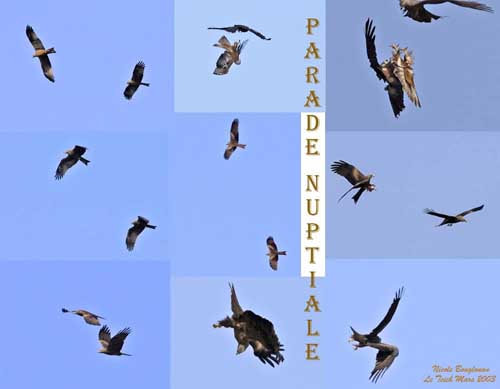
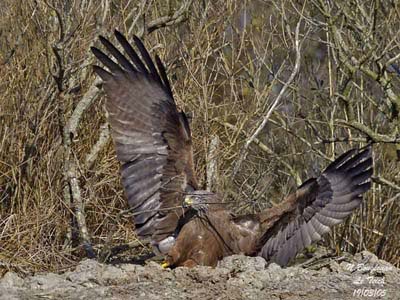
While preparing the reproduction period, the nest construction makes good progress. It is necessary to collect materials, dry sticks, grass, and various things which will be used as interior decoration, such as papers, rags, plastics…

The Black Kite’s eyrie is placed in the fork of a tree, and can be used year after year.
Copulations and pair bonds are in progress. Male and female strengthen their bonds each day, by the displays, the assiduous court of the male, and copulations.
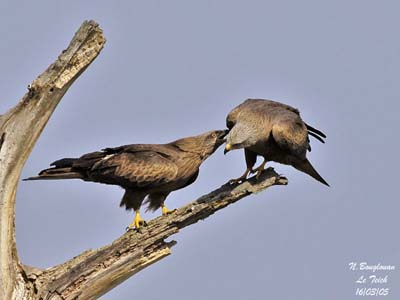
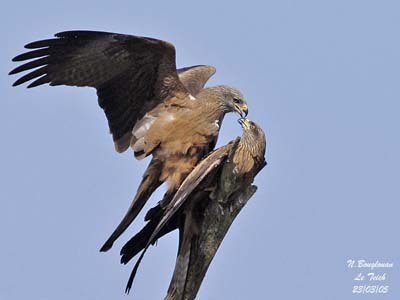
The laying period finally comes. The female lays two or three eggs in April. The incubation lasts about thirty-eight days, carried out by the female, while the male remains in the neighbourhoods of the nest, and feeds her.
The Black Kite is not a great hunter; this is why it feeds on dead or injured animals. It consumes sick or dead fish, carrions, small mammals, amphibians, molluscs, insects and birds, particularly the chicks in henhouses, but also young ducks living on the same ponds where it stays, and also those of the wild birds.
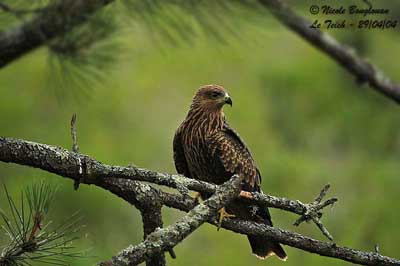
Now is time to born. The chicks are covered with silky, white down on head and neck, with black patch through the eyes. The body plumage is pinkish-brown, with white underparts. At one month, they have already an almost complete plumage, and they remain close to the nest. Ten days later, they settle in the surrounding, and the female still feeds them. Thirty to forty five days later, they are ready for the migration. Their mottled plumage makes them different, but they cut already the fine figure of their parents.
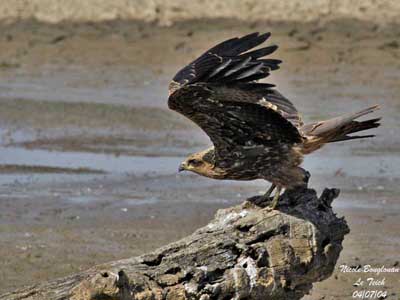
But before to leave, it is necessary to be able to use the wings, and it is no small matter. Tests are increasing on the ground, going from branch to branch, and then a little higher. The young kite performs wing beats on the ground to be aware of its capacity, perches at treetop to test its wind resistance. In fact, it learns this ability that humans always envied the birds, to fly!
And August arrives so quickly! They have just born and already, it is necessary to think of leaving! The young flies longer and longer, higher and higher, tests the turns, the various positions which will help it for crossing this strength test successfully. The sky calls him, with a reward at the end, to winter in tropical Africa.
Within a few days, they disappear from our area, the forest does not hear more their calls, the sky seems to be empty, I would almost dare to say that we miss something…
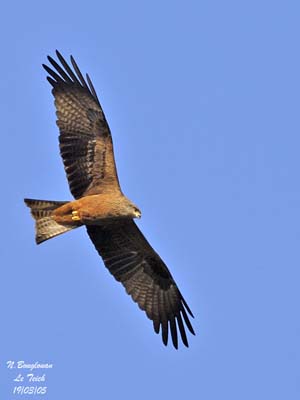
The Black Kite is a regular summer visitor in our regions. It lives in forests close to water which gives him food resources. It became one of the most common raptors, frequenting the dumps and cleaning the nature, by removing the dead animals as effectively as a corvidae. Its beauty, its elegance, its virtuosity in flight, its piercing look and its frequent calls, made of him an attaching bird of prey.
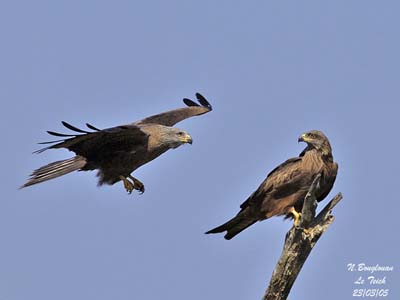
I will miss it this winter, but the hope to see it again next year at the same place, already fills me of joy. I will not forget the female’s glance while calling and awaiting the male right before mating, and this magic moment where the two partners met to ensure the future of their species…
Text and photographs by Nicole Bouglouan
Sources :
Personal observations in the fields.
THE HANDBOOK OF BIRD IDENTIFICATION FOR EUROPE AND THE WESTERN PALEARCTIC, by Mark Beaman, Steve Madge - C.Helm - ISBN: 0713639601
Wikipedia (Wikipedia, The Free Encyclopedia)
Pájaros de España (JL Beamonte)
The Hawk Conservancy Trust (Hilary Smith)